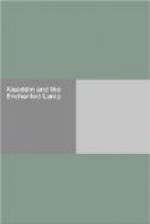[FN#539] Kull muddeh.
[FN#540] Labu ’l andab, lit. “arrow-play.”
[FN#541] Night DLXXIII.
[FN#542] Szerayeh.
[FN#543] Keszr.
[FN#544] Burton adds, “and confections.”
[FN#545] Lit. “he set them down the stablest or skilfullest (mustehhkem) setting down.”
[FN#546] Hherrem, i.e. arranged them, according to the rules of the geomantic art.
[FN#547] Netsera jeyyidan fi. Burton, “He firmly established the sequence of.”
[FN#548] Technical names of the primary and secondary figures. The following account of the geomantic process, as described by Arabic writers de re magicf, is mainly derived from the Mukeddimat or Prolegomena of Abdurrehman ibn Aboubekr Mohammed (better known as Ibn Khaldoun) to his great work of universal history. Those (says he) who seek to discover hidden things and know the future have invented an art which they call tracing or smiting the sand; to wit, they take paper or sand or flour and trace thereon at hazard four rows of points, which operation, three times repeated (i.e. four times performed), gives sixteen rows. These points they eliminate two by two, all but the last (if the number of the points of a row be odd) or the last two (if it he even) of each row. by which means they obtain sixteen points, single or double. These they divide into four figures, each representing the residual points of four lines, set one under another, and these four figures, which are called the mothers or primaries, they place side by side in one line. From these primaries they extract four fresh figures by confronting each point with the corresponding point in the next figure, and counting for each pair a single or double point, according to one of two rules, i.e. (1) setting down a single point for each single point being on the same line with another point, whether single or double, and a double point for. each pair of double points in line with each other, or (2) reckoning a double point for each pair of like points (single or double), corresponding one with another on the same line’ and a single point for each, unlike pair. These new figures (as well as those that follow) are called the daughters or secondaries and are placed beside the primaries, by confrontation with which (i,e, 5 with 1, 6 with 2, 7 with 3 and " with 4) four fresh figures are obtained after the same fashion and placed side by side below the first eight. From this second row a thirteenth and fourteenth figure are obtained in the same way (confronting 9 with lo and 1 l with 12)) and placed beneath them, as a third row. The two new figures, confronted with each other, in like manner, furnish a fifteenth figure, which, being confronted with the first of the primaries, gives a sixteenth and last figure, completing the series. Then (says our author), the geomant proceeds to examine the sixteen figures thus obtained (each of which has its name and its mansion, corresponding to one of




